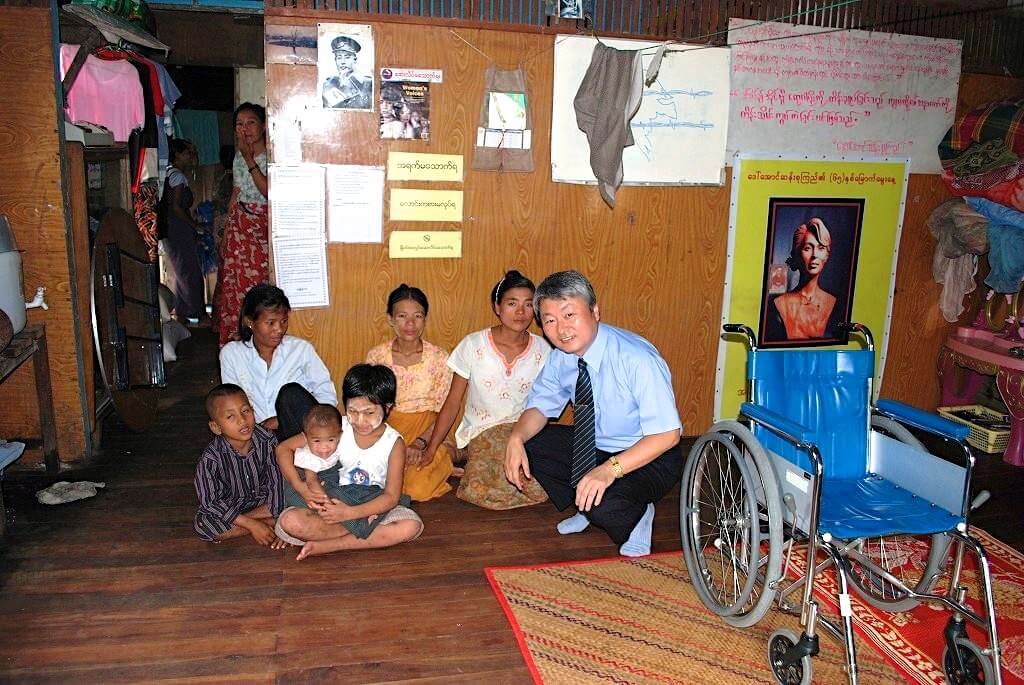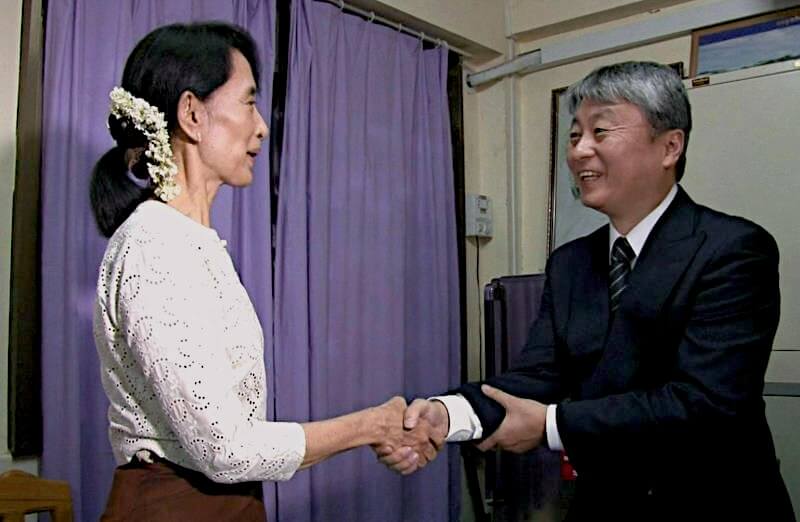
Takamori Takuya was born in Hyogo, Japan in 1960. His passion for teaching led him to start his own private school in Tokyo when he was 25 years old. 10 years later, he established his Futokuro Children’s NGO.
Takamori, an avid traveler, began teaching Japanese children about different cultures and lifestyles throughout the world that he had explored. Later, he felt the children would benefit more from their own firsthand experiences, and he started taking groups of Japanese children to foreign countries in 1998.
His love for Myanmar and Burmese culture led him to discover the sport of Lethwei during his first trip there in 1997. Soon after, he volunteered his time to become the event coordinator for all the major Myanmar/Japan Lethwei shows from 2004 through 2012, working alongside his fellow Japanese team members: Yoshinori Nishi, Masami Ozaki, and Toshio Fujiwara.
Takamori currently lives with his Burmese wife in the deep countryside of western Tokyo.

You love to travel. Where did your interest in Myanmar begin?
My fascination with Myanmar began in my youth. My family took me and my younger brother on a trip to visit the Japan World Exposition (Expo 70) in Osaka in 1970. It was a big event with 77 countries taking part, and a staggering number of visitors.
Each country’s pavilion had many people waiting to get in. The wait time for each pavilion was three hours or more. My family didn’t have much time because we had to catch our train back home. So, we went looking for a pavilion that we could get into quickly. We found only one. It was a very small pavilion, and when we went inside, we were the only ones there. I felt that it was so sad because no one seemed interested in it at all. When I got outside, I wanted to know the pavilion’s name. I looked up, and I saw that the country was Burma. I was only 10 years old at the time, but I decided that when I grew up, I would go to Burma one day.
In my late 20s, I started traveling around the world. My first trip was to New York in 1986. Then I traveled to Africa, Asia, and South America. While traveling, I was always making plans to visit Myanmar, since it was my childhood dream to go there.
I continued finding out as much as I could about Myanmar because I was interested in experiencing the old traditions before they vanished. In my research, I discovered Lethwei was a part of that ancient traditional culture.
When did you first see or experience Lethwei?
I got to see a live Lethwei event on my first trip to Myanmar in 1997. I asked my travel agency in Japan to see if they could find any Lethwei shows that I could attend while I was there. One day, I heard the news that there was a Lethwei event happening in Hinthada during my stay.
I was fortunately able to meet U Win Zin Oo in Yangon. He has been involved with Lethwei all his life, but more than that, he is a wonderful human being, and a deeply spiritual man. We became fast friends. He took me to the Hinthada event.
Personally, it was a very exciting and interesting experience, viewing Lethwei up-close for the first time. Lethwei is one of the toughest, most aggressive martial arts that I have ever seen. The speed and technical ability of the fighters is staggering.

Did any of the Lethwei fighters stand out to you?
I was very impressed with Saw Thei Myo and Saw Thei Aung.
You became heavily involved in Lethwei after this trip. How did this begin for you?
I volunteered. I have been a coordinator, handling the Japanese side of the Myanmar Lethwei events, since 2004. The Myanmar vs. Japan fight cards were held a total of nine times. I don’t work as a fight coordinator in my professional life, but I wanted to be involved in any way I could to help the sport. I often used my own money to purchase whatever was needed. It was and still is a passion of mine.
I always felt that both countries’ audiences respect the Asian martial-arts culture of Letwhei. They clap enthusiastically for whoever wins or loses; be it either Japan or Myanmar. There is no difference. The promotors and the media likewise have shown great support for the shows.
I worked very hard to introduce the sport of Lethwei to Japan through TV programs, newspapers, and magazines.
You continued traveling back and forth to Myanmar, but some of your work went beyond Lethwei. What other projects were you involved in?
I visited Myanmar many times since then to support the children of Myanmar and to watch Lethwei fights. I watched hundreds of Lethwei fights in Myanmar.
My life and work is my Children’s NGO. I have been involved in many activities in Myanmar since 1995. I worked on fundraising activities in Japan to get polio vaccines for the children of Myanmar. I also supported the victims of Cyclone Nargis, and the HIV/AIDS community there. Because of this, I was very fortunate to have a meeting with Daw Aung San Suu Kyi regarding education in 2011. I have been involved in educational medical support for the children of Myanmar for over 25 years.

You started to research and dig into the origins of the sport. What were some of your findings?
I wanted to research and understand the origins of Myanmar Lethwei. My search brought me to the ancient city of Bagan in 2005. I looked for the evidence myself, and I conducted interviews with many of the villagers in the surrounding villages. I found the ancient wall murals that were painted about 800-950 years ago, which contained the evidence I was looking for. I showed the pictures that I took in Bagan to U Win Zin Oo and U Zin Lin Htun in U Win Zin Oo’s house when I returned to Yangon. They were very surprised at my findings. Nobody in the Lethwei world had really researched or known about the ancient wall paintings.
You see Lethwei as much more than a fighting event. What does it represent to you?
Lethwei events are not just fights. They are a big bridge between Myanmar and Japan. They should be seen as an international goodwill exchange, too. This was always very important to me.
Now, Lethwei is very well-known on social media and the internet, but in the years before the opening of the country, there was very limited internet access. There was no YouTube. Lethwei had very limited visibility, so many people knew little about the sport.
Today, there are many promoters and live events. People are now very excited about the sport, and more and more foreign fighters are taking part.
I want Lethwei to shine — not only in Myanmar and in Asia, but throughout the world.
I believe Lethwei should be registered as an Intangible Cultural Heritage by UNESCO.
Lethwei is an art of great beauty, and, in the end, a very important part of the traditional culture of Myanmar.
© 2020 Vincent Giordano. Unauthorized use and/or duplication of this material without the express written permission from the author is strictly prohibited.

Leave a Reply
You must be logged in to post a comment.